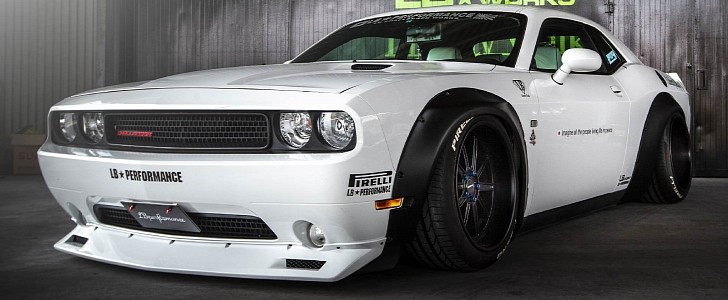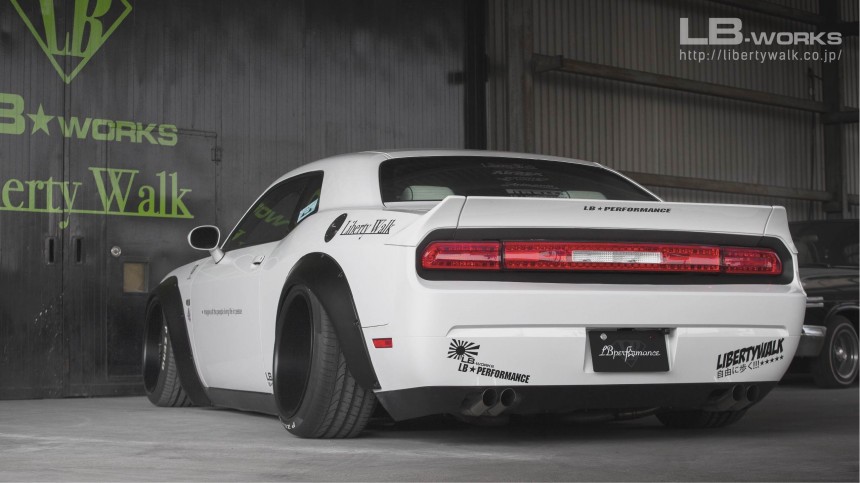The Challenger’s future is electric. Dodge has said it more than once, and they are currently bidding farewell to it with a few novelties for the 2023 model year. Thus, if we were you, we’d enjoy our dreamy V8-powered, preferably in one of the Hellcat configurations, muscle car from Dodge while we still can, and we’d go crazy on it, no matter what others say.
If you feel that the ‘crazy’ part is something that needs to happen, then perhaps Liberty Walk can make your wish come true. Sure, all their proposals look just about the same, but there is something strangely appealing about the body kits signed by the tuner based in the Land of the Rising Sun, as far as this writer is concerned anyway.
Thus, it’s no wonder that I jumped on yet another such project, the umpteenth one made by Liberty Walk for the Dodge Challenger, which looks ready to go up a mountain sideways – if you forget that this muscle car is not exactly a peach to drive on twisty roads. I’d also give it a role in the upcoming ‘Fast and Furious’ movie, maybe with a few mods here and there, and put the villain behind the wheel.
But enough daydreaming, as we should move on to what actually matters: the novelties. Starting up front, the aging muscle car has a humongous apron, Bosozoku-style. The typical fender flares, with a bolt-on design, bedeck the sides, and out back, it has a new bumper, with an integrated diffuser that features cutouts for the different tailpipes. There is a bigger ducktail spoiler on the trunk lid, with a pair of attachments to the sides, and new taillights.
Filling the wheel arches are the extremely wide alloys, with a ten-spoke design. They have a black look, sport Liberty Walk’s logo on the center caps, and are hugged by the Pirelli P Zero tires with white branding. A few black elements provide some contrast to the white body of this tuned Dodge Challenger, which also gets the usual decals all around.
In terms of pricing, you are looking at $5,780 for the complete body kit, made of FRP, which comprises the fender flares, ducktail spoiler, and front lip. Without the latter part, the cost drops to $4,800 for abroad markets, Liberty Walk says. Also, you will have to spend more money in order to make your Dodge Challenger look exactly like this, as the wheels are optional, and so is the air suspension, and they haven’t said anything about how much more you will have to fork out for them.
Moreover, you’d better be okay with the output and torque produced by the engine of your Challenger, because in case you forgot, Liberty Walk is not known for boosting the oily bits of their projects. Still, there are many other tuning companies out there that would gladly answer the call, and depending on what engine powers your Dodge muscle car, they could make it way punchier than the original Bugatti Veyron.
The most powerful version of the Challenger to date remains the SRT Demon, which, with a lot of prepping, boasts 840 hp and 770 lb-ft (1,044 Nm) of torque. It takes as low as 2.3 seconds to hit 60 mph (97 kph) from a standstill, and was basically born at the drag strip. The Jailbreak and SRT Super Stock use the same supercharged 6.2-liter HEMI V8, albeit with 807 hp and 707 lb-ft (959 Nm), whereas the SRT Hellcat Redeye and SRT Hellcat Redeye Widebody have 10 hp less, and identical thrust. The two ‘normal’ Hellcats enjoy 717 hp and 656 lb-ft (889 Nm), which is still supercar territory.
Thus, it’s no wonder that I jumped on yet another such project, the umpteenth one made by Liberty Walk for the Dodge Challenger, which looks ready to go up a mountain sideways – if you forget that this muscle car is not exactly a peach to drive on twisty roads. I’d also give it a role in the upcoming ‘Fast and Furious’ movie, maybe with a few mods here and there, and put the villain behind the wheel.
But enough daydreaming, as we should move on to what actually matters: the novelties. Starting up front, the aging muscle car has a humongous apron, Bosozoku-style. The typical fender flares, with a bolt-on design, bedeck the sides, and out back, it has a new bumper, with an integrated diffuser that features cutouts for the different tailpipes. There is a bigger ducktail spoiler on the trunk lid, with a pair of attachments to the sides, and new taillights.
In terms of pricing, you are looking at $5,780 for the complete body kit, made of FRP, which comprises the fender flares, ducktail spoiler, and front lip. Without the latter part, the cost drops to $4,800 for abroad markets, Liberty Walk says. Also, you will have to spend more money in order to make your Dodge Challenger look exactly like this, as the wheels are optional, and so is the air suspension, and they haven’t said anything about how much more you will have to fork out for them.
Moreover, you’d better be okay with the output and torque produced by the engine of your Challenger, because in case you forgot, Liberty Walk is not known for boosting the oily bits of their projects. Still, there are many other tuning companies out there that would gladly answer the call, and depending on what engine powers your Dodge muscle car, they could make it way punchier than the original Bugatti Veyron.
The most powerful version of the Challenger to date remains the SRT Demon, which, with a lot of prepping, boasts 840 hp and 770 lb-ft (1,044 Nm) of torque. It takes as low as 2.3 seconds to hit 60 mph (97 kph) from a standstill, and was basically born at the drag strip. The Jailbreak and SRT Super Stock use the same supercharged 6.2-liter HEMI V8, albeit with 807 hp and 707 lb-ft (959 Nm), whereas the SRT Hellcat Redeye and SRT Hellcat Redeye Widebody have 10 hp less, and identical thrust. The two ‘normal’ Hellcats enjoy 717 hp and 656 lb-ft (889 Nm), which is still supercar territory.













